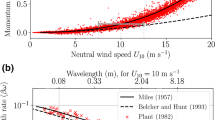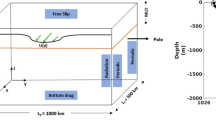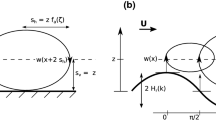Abstract
Success in scaling the very stable boundary layer has been mixed. One possible reason for this is that wave-turbulence interaction can result in significant energy coupling between turbulence within the planetary boundary layer and the mean flow outside the PBL. Three regimes are described where wave-turbulence interaction forms a significant part of the dynamics. In the first, energy and momentum flows are confined within the PBL and do not preclude local scaling. In the other two, which involve topographically forced waves and propagating waves respectively, energy/momentum transfers across the PBL make success in local scaling unlikely.
Similar content being viewed by others
References
Andren, A.: 1995, ‘The Structure of Stably Stratified Atmospheric Boundary Layers: A Large-Eddy Simulation Study’, Quart. J. Roy. Meteorol. Soc. 121, 961–985.
Chimonas, G.: 1993, ‘Surface Drag Instabilities in the Atmospheric Boundary Layer’, J. Atmos. Sci. 50, 1914–1924.
Chimonas, G.: 1999, ‘Steps, Waves and Turbulence in the Stably Stratified Planetary Boundary Layer’, Boundary-Layer Meteorol., this issue.
Derbyshire, S. H.: 1999, ‘Stable Boundary-Layer Modelling: Established Approaches and Beyond’, Boundary-Layer Meteorol., this issue.
Durran, D. R.: 1990, ‘Mountain Waves and Downslope Winds’, in W. Blumen (ed.), Atmospheric Processes over Complex, American Meteorol. Soc. Meteorological Monograph No. 45, pp. 59–82.
Egger, J.: 1990, ‘Thermally Forced Flows: Theory’, in W. Blumen (ed.), Atmospheric Processes over Complex Terrain, American Meteorol. Soc. Meteorological Monograph No. 45, pp 43–58
Edwards, N. R. and Mobbs, S. D.: 1997a, ‘Observations of Isolated Wave-Turbulence Interactions in the Stable Atmospheric Boundary Layer’, Quart. J. Roy. Meteorol. Soc. 123, 561–584.
Edwards, N. R. and Mobbs, S. D.: 1997b, ‘Modelling Isolated Wave-Turbulence Interactions in the Stable Atmospheric Boundary Layer’, Quart. J. Roy. Meteorol. Soc. 123, 585–604.
Einaudi, F. and Finnigan, J. J.: 1981, ‘The Interaction between an Internal Gravity Wave and the Planetary Boundary Layer. Part I: The Linear Analysis’, Quart. J. Roy. Meteorol. Soc. 107, 793–806.
Einaudi, F. and Finnigan, J. J.: 1993, ‘Wave-Turbulence Dynamics in the Stably Stratified Boundary Layer’, J. Atmos. Sci. 50, 1841–1864.
Einaudi, F., Finnigan, J. J., and Fua, D.: 1984, ‘Gravity Wave Turbulence Interaction in the Presence of a Critical Level’, J. Atmos. Sci. 41, 661–667.
Einaudi, F., Bedard, A. J. Jr., and Finnigan, J. J.: 1989, ‘A Climatology of Gravity Waves and Other Coherent Disturbances at the Boulder Atmospheric Observatory during March-April 1984’, J. Atmos. Sci. 46, 303–329.
Finnigan, J. J.: 1988, ‘Kinetic Energy Transfer between Internal Gravity Waves and Turbulence’, J. Atmos. Sci. 45, 486–505.
Finnigan, J. J. and Einaudi, F.: 1981, ‘The Interaction between an Internal Gravity Wave and the Planetary Boundary Layer. Part II: Effect of the Wave on the Turbulence Structure’, Quart. J. Roy. Meteorol. Soc. 107, 807–832.
Finnigan, J. J., Einaudi, F., and Fua, D.: 1984, ‘The Interaction between an Internal Gravity Wave and Turbulence in the Stably-Stratified Nocturnal Boundary Layer’, J. Atmos. Sci. 41, 2409–2436.
Fua, D., Chimonas, G., Einaudi, F., and Zeman, O.: 1982, ‘An Analysis of Wave-Turbulence Interaction’, J. Atmos. Sci. 39, 2450–2463.
Grant, A. L. M.: 1997, ‘An Observational Study of the Evening Transition Boundary Layer’, Quart. J. Roy. Meteorol. Soc. 123, 657–678.
Holtslag, A. A. M. and Nieuwstadt, F. T. M.: 1986, ‘Scaling the Atmospheric Boundary Layer’, Boundary-Layer Meteorol. 36, 201–209.
Howard, L. N.: 1961, ‘Note on a Paper of John W. Miles’, J. Fluid Mech. 10, 509–512.
Jeffreys, H.: 1925, ‘The Flow of Water in an Inclined Channel of Rectangular Section’, Phil. Mag. 49, 793–807.
Lilly, D. K.: 1969, ‘Numerical Simulation of Two-Dimensional Turbulence’, Phys. Fluids 11(Suppl. II), 240–249.
Mahrt, L.: 1999, ‘Stratified Atmospheric Boundary Layers’, Boundary-Layer Meteorol., this issue.
Meroney, R. N.: 1990, ‘Fluid Dynamics of Flow over Hills/Mountains-Insights Obtained through Physical Modelling’, in W. Blumen (ed.), Atmospheric Processes over Complex Terrain, American Meteorol. Soc. Meteorological Monograph No. 45, pp 145–172.
Miles, J. W.: 1961, ‘On the Stability of Heterogeneous Shear Flow’, J. Fluid. Mech. 10, 496–508.
Nappo, C. J.: 1992, ‘Gravity Wave-Generated Turbulence in the Stable Boundary Layer over Complex Terrain’, in Preprints of the 10th Symposium on Turbulence and Diffusion, Portland, Oregon, Amer. Meteorol. Soc. (J4)64–67.
Nappo, C. J. and Chimonas, G.: 1992, ‘Wave Exchange between the Ground Surface and a Boundary Layer Critical Level’, J. Atmos. Sci. 49, 1075–1091.
Nappo, C. J., Eckman, R. M., and Coulter, R. L.: 1992, ‘An Episode of Wave-Generated Turbulence in the Stable Planetary Boundary Layer’, in Preprints of the 10th Symposium on Turbulence and Diffusion, Portland, Oregon, Amer. Meteorol. Soc. 118–122.
Nieuwstadt, F. T. M.: 1984:, ‘The Turbulent Structure of the Stable Nocturnal Boundary Layer’, J. Atmos. Sci. 41, 2202–2216.
Smith, R. B.: 1989, ‘Comments on “Low Froude Number Flow Past Three Dimensional Obstacles. Part 1; Baroclinically Generated Lee Vortices”’, J. Atmos. Sci. 46, 3611–3613.
Smolarkiewicz, P. K. and Rotunno, R.: 1989a:, ‘Low Froude Number Flow Past Three Dimensional Obstacles. Part 1; Baroclinically Generated Lee Vortices’, J. Atmos. Sci. 46, 1154–1164.
Smolarkiewicz, P. K. and Rotunno, R.: 1989b, ‘Reply’, J. Atmos. Sci. 46, 3614–3617.
Sykes, R. I. and Lewellen, W. S.: 1982:, ‘A Numerical Study of Breaking Kelvin-Helmholtz Billows Using a Reynolds-Stress Turbulence Closure’, J. Atmos. Sci. 39, 1506–1520.
Thorpe, S. A.: 1973, ‘Experiments on Instability and Turbulence in a Stratified Shear Flow’, Fluid Mech. 61, 731–751.
Author information
Authors and Affiliations
Rights and permissions
About this article
Cite this article
Finnigan, J. A Note on Wave-Turbulence Interaction and the Possibility of Scaling the Very Stable Boundary Layer. Boundary-Layer Meteorology 90, 529–539 (1999). https://doi.org/10.1023/A:1001756912935
Issue Date:
DOI: https://doi.org/10.1023/A:1001756912935




